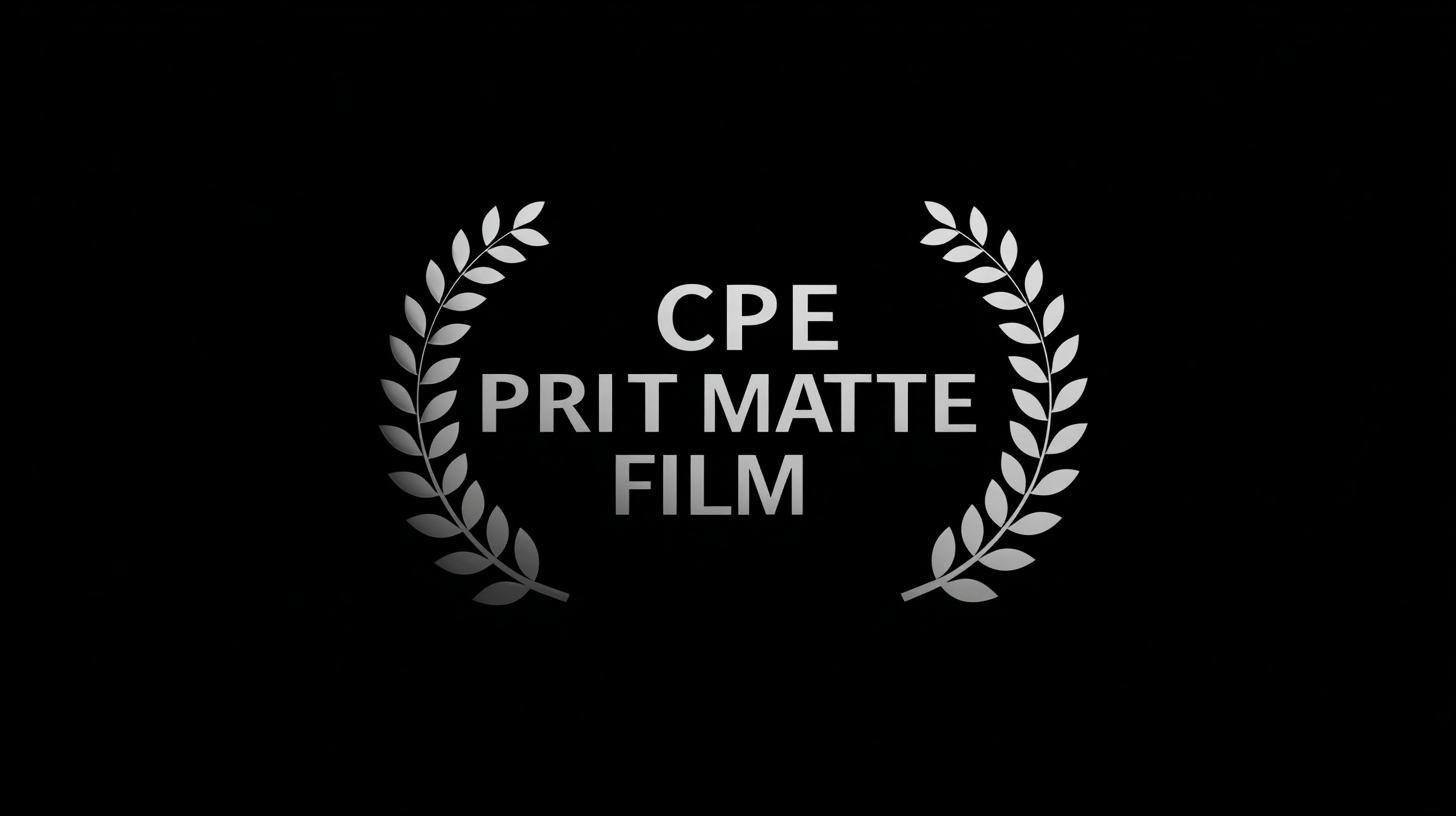
Comparative Analysis of the Leading CPP Matte Film: Industry Insights and Performance Metrics
The CPP Matte Film industry is witnessing significant advancements, driven by growing consumer demand for high-quality packaging solutions. According to a recent report by Smithers Pira, the global demand for CPP films is projected to reach approximately 3 million tons by 2025, with matte variants representing a key segment of this growth due to their superior aesthetic appeal and functionality.

CPP Matte Film is increasingly favored across various sectors, including food packaging, personal care, and electronics, owing to its excellent barrier properties and consumer-friendly characteristics. As manufacturers focus on sustainability and innovation, understanding the competitive landscape, industry insights, and performance metrics of leading CPP Matte Film producers becomes crucial for stakeholders looking to capitalize on emerging opportunities in this dynamic market.
This blog aims to provide a comparative analysis of the leading CPP Matte Film options, highlighting their performance metrics and industry implications for future developments.
Applications of CPP Matte Film in Packaging Solutions
CPP matte film, recognized for its excellent barrier properties and aesthetic appeal, is increasingly being utilized in packaging solutions across various industries. According to a recent report by Smithers Pira, the demand for CPP films is projected to grow at a CAGR of 4.5% over the next five years, driven by the packaging sector's need for materials that provide durability while enhancing product presentation. The unique matte finish not only improves the tactile experience but also reduces glare, making it ideal for applications in food packaging, cosmetic products, and electronic devices.

When considering the implementation of CPP matte films, companies should recognize their advantages in maintaining product freshness and extending shelf life. For instance, a case study by the Flexible Packaging Association highlighted how companies using CPP matte films in their packaging solutions reported a 20% increase in product longevity compared to traditional alternatives. To maximize these benefits, it is crucial to select a film thickness that aligns with specific product requirements and to prioritize suppliers who demonstrate a commitment to quality and sustainability.
Tip: Always conduct thorough testing of CPP matte films with your specific product types to ensure compatibility and optimal performance. Additionally, consider leveraging innovative packaging designs that fully exploit the matte film's aesthetic benefits—this can significantly enhance brand appeal and consumer engagement.
Performance Metrics: Evaluating CPP Matte Film Durability and Quality
When evaluating the performance metrics of CPP matte film,
durability and quality emerge as critical aspects that define its overall effectiveness in various applications.
The durability of CPP matte films is often gauged through rigorous testing processes, including
tensile strength assessments and resistance to environmental factors such as moisture and temperature fluctuations.
These tests allow manufacturers and end-users to determine how well the film can withstand physical stress and maintain
integrity over time, a crucial parameter for packaging solutions that demand long-lasting performance.
Quality, on the other hand, encompasses more than just physical resiliency.
It also includes optical properties such as light diffusion and surface finish, which play a vital role in aesthetic applications.
The right CPP matte film not only enhances product appearance but also reduces glare and improves visual clarity for consumers.
Key metrics for assessing quality typically involve clarity testing, surface smoothness measurements, and consistency across
different batches. By carefully analyzing these performance indicators, businesses can make informed decisions about which
CPP matte films best meet their specific needs, ensuring optimal functionality and visual appeal in their products.
Industry Case Studies: Successful CPP Matte Film Implementations
The implementation of CPP matte film in various industries has garnered attention due to its versatile applications and enhanced performance characteristics. One notable case study is from the packaging sector, where a leading snack manufacturer adopted CPP matte film for its product line. This transition led to improved barrier properties, extending the shelf life of their products while maintaining optimal aesthetics. The matte finish not only elevated the visual appeal on retail shelves, but also provided a tactile experience that resonated with consumers, ultimately driving sales upwards.
In the cosmetics industry, another compelling example can be found with a skincare brand that integrated CPP matte film into their packaging solutions. The brand experienced a significant reduction in packaging costs while reaping the benefits of superior printability and graphic clarity. The film's lightweight nature allowed for lower shipping expenses, contributing to a greener supply chain. Customer feedback indicated that the matte finish projected luxury and sophistication, aligning perfectly with the brand's identity. These case studies highlight the versatility and effectiveness of CPP matte film, showcasing its integral role in enhancing product performance and consumer perception across various markets.
Comparative Analysis of Cost-Effectiveness in CPP Matte Film Usage
The cost-effectiveness of CPP (Cast Polypropylene) matte film usage has become a pivotal consideration for manufacturers in the packaging industry. According to the latest market research report by Smithers Pira, CPP matte films exhibit a 10-15% lower production cost compared to traditional BOPP films, primarily due to their lower weight and optimized material properties. This reduction in material costs becomes increasingly significant when considering large-scale production runs, where economies of scale can further amplify savings.
Moreover, the durability and barrier properties of CPP matte films contribute to long-term cost efficiency. A study by the Flexible Packaging Association highlighted that CPP films can extend product shelf life by up to 20%, reducing spoilage and waste in food applications. With these films offering moisture barriers and excellent clarity, businesses can not only save on raw material costs but also minimize losses due to product degradation. As the demand for sustainable packaging solutions continues to rise, CPP matte films emerge as a financially savvy choice that meets both industry performance metrics and eco-conscious criteria.

Future Trends: Innovations in CPP Matte Film for Diverse Industries
The CPP matte film market is experiencing a transformative phase, driven by innovations that cater to diverse industry needs. According to a recent report by MarketsandMarkets, the CPP film market is projected to grow from $1.7 billion in 2023 to $2.5 billion by 2028, at a CAGR of 7.3%. This growth is fueled by advancements in material science and processing techniques, enabling manufacturers to develop films that offer enhanced barrier properties and superior aesthetics. As industries shift towards more sustainable practices, innovations such as bio-based CPP films are starting to gain traction, appealing to eco-conscious brands.
Moreover, the integration of nanotechnology in CPP matte films is poised to revolutionize their functionalities. Research from the Technical Association of the Pulp and Paper Industry (TAPPI) highlights that nano-enhanced films provide improved tensile strength and flexibility while maintaining a visually appealing matte finish. This capability is particularly advantageous for packaging applications in sectors like food, cosmetics, and electronics. As industries prioritize both product integrity and consumer appeal, the future of CPP matte films looks promising, with continuous technological advancements paving the way for new applications and market expansions.
Comparative Analysis of the Leading CPP Matte Film: Industry Insights and Performance Metrics - Future Trends: Innovations in CPP Matte Film for Diverse Industries
| Property | Industry Application | Performance Metric | Future Trend |
|---|---|---|---|
| Transparency | Packaging | >90% | Development of ultra-clear coatings |
| Gloss Level | Electronics | Low to High | Enhanced matte finishes for aesthetic appeal |
| Barrier Properties | Food & Beverage | Oxygen: 2 cc/m²/day | Bio-based barrier materials |
| Mechanical Strength | Automotive | Tensile strength: 35 MPa | Incorporation of nanomaterials |
| Thermal Resistance | Medical | Up to 80°C | Heat-resistant variants |
